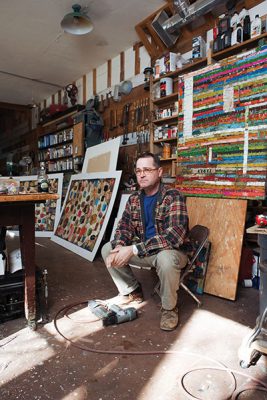THE ACCLAIMED AUSTIN ARTIST IS FEATURED IN A DOC THAT PREMIERED AT SXSW
What’s its significance, do you know?” Lance Letscher asks, sounding genuinely curious. He’s standing in his studio before “Blue Hand,” his new collage-in-progress, and has just been told it closely resembles a hamsa, the ancient palm-shaped symbol that’s now a trendy women’s jewelry motif. Letscher’s “Hand,” however, is huge—a pastiche of metal in many shades of impossibly beautiful cobalt blue, overlaid with a scattering of crisscrossed staples. “The wider staples are bluish,” he says, “and the narrow ones overlapped on top are a copper that makes it really radiant. That’s just decorative,” he adds. “Nothing profound.”
Details, not meanings, are what drive the work of Letscher, a native Austinite who’s now internationally famous for taking bits of old books, posters, album covers and other found ephemera and assembling them into startlingly intricate museum-quality art. The metal for “Blue Hand” came from cookie tins and signs in India, but other Letscher work might contain (for starters) minutely spliced scraps from handwritten recipes, board games, ledgers, diaries or Montgomery-Ward catalogs, or even tiny outlined images of scissors themselves, clipped from a 1960s coloring book.
Metal is a new direction for Letscher, who apprenticed with artist Amado Peña in the 1980s before gravitating from sculpture to collage. He’s been into everyday artifacts since childhood, when he helped his grandparents clean out their rental properties in Paris, Texas. Thirty years ago, as an art student at UT, he was Dumpster-digging for paper at Half Price Books on the Drag when employee Sheri Tornatore spotted him and became a friend. Today she owns South Congress Books and still brings him boxes of vintage stuff—and recently, indirectly, brought something else. Owners of her building commissioned Letscher to do an outdoor metal mural on a side wall of her store.
That project caught the eye of the owners’ cousin, Sandra Adair—Oscar-nominated editor of Boyhood, Bernie and many other Richard Linklater films. At first she thought she’d photograph the mural, but, meeting Letscher, decided to make a documentary about him. For 18 months, her cameraman, Jason Gamble Harter, hung out with the artist almost daily in his Brentwood studio, loaning him a GoPro to film himself when working alone. The Secret Life of Lance Letscher is headed for release this spring.
Adair appreciates the parallel of one cutter-and-paster profiling another. “Our processes are similar in many ways,” she says. “Lance lets the materials he finds speak to him, then reassembles them to give them an entirely different meaning. I look through film footage, find the images that speak to me, and put them in a new order too.”
“Not quite terror—somewhere between anxiety and panic” is how Letscher, an avowed introvert, describes agreeing to be filmed. Other than writing a children’s book in 2010, “this was the only time I’d done anything remotely autobiographical,” he says.
Well, not quite. It’s true that his art, for all its reconstituted concrete objects, might be called emphatically abstract. But there’s a personal story of sorts—of one artist operating on two tracks. For instance, one canvas in his studio shows a relatively orderly sequence of cubes. Three feet away, another work revolves around a woman with plates spinning overhead, surrounded by slanting mechanical contraptions, clapping hands and a swirly border of cheery red excised from a Jimmy Dorsey LP.
“Around 2010, the work changed dramatically,” Letscher confirms, “going from more pattern-based to really kinetic and dense.” One reason: in that year, his father committed suicide. “I don’t base my life history around that event,” he matter-of-factly adds. “But the work started to become more expressionistic, more about emotion and, frankly, psychiatric issues.”
Yet it’s how those images work together that animates Letscher, who in conversation clearly loves to geek out about subtleties of warm-cool opposition, perspective and negative space. “I can remember just intensely looking at things when I was a little kid. My first memories were visual.” Once he starts an artwork, “there may be some kind of story that starts to develop,” he concedes, but the materials lead the show. “I just look; I look really hard. I concentrate.”

